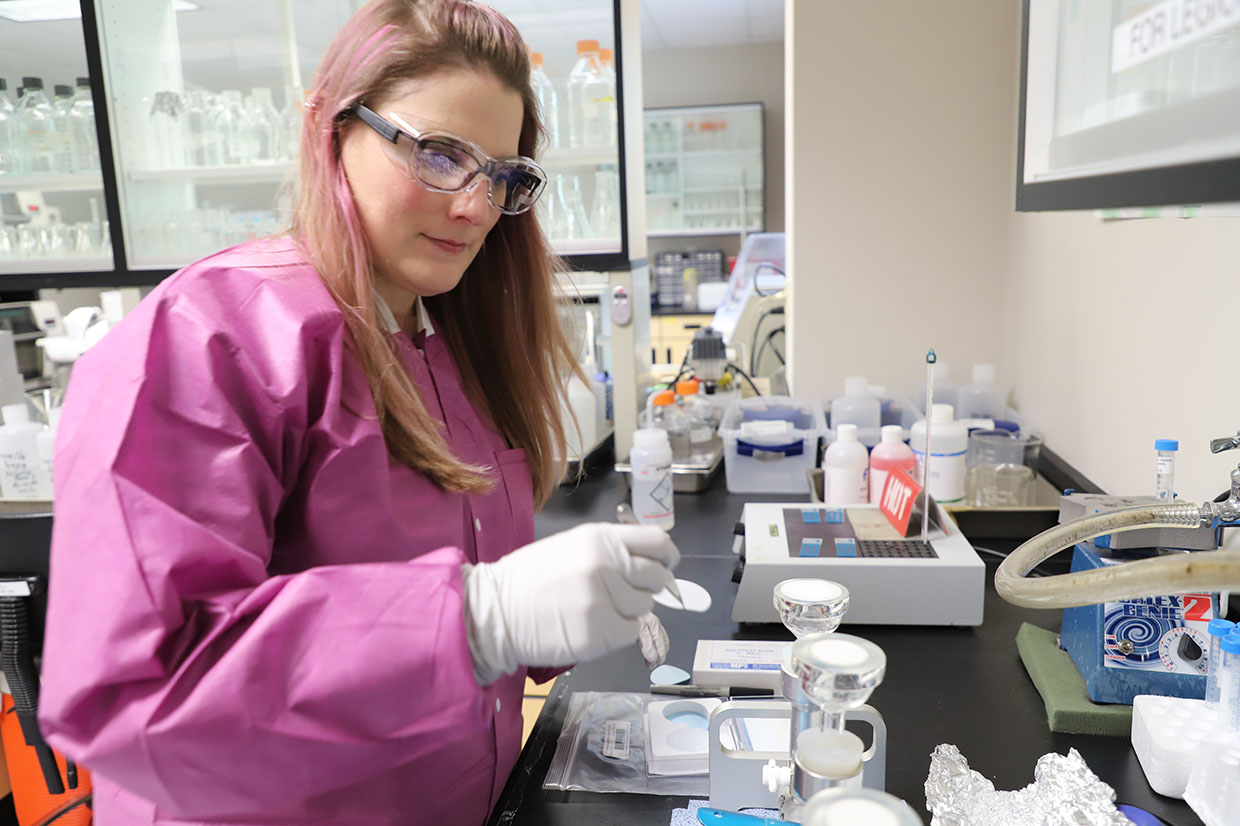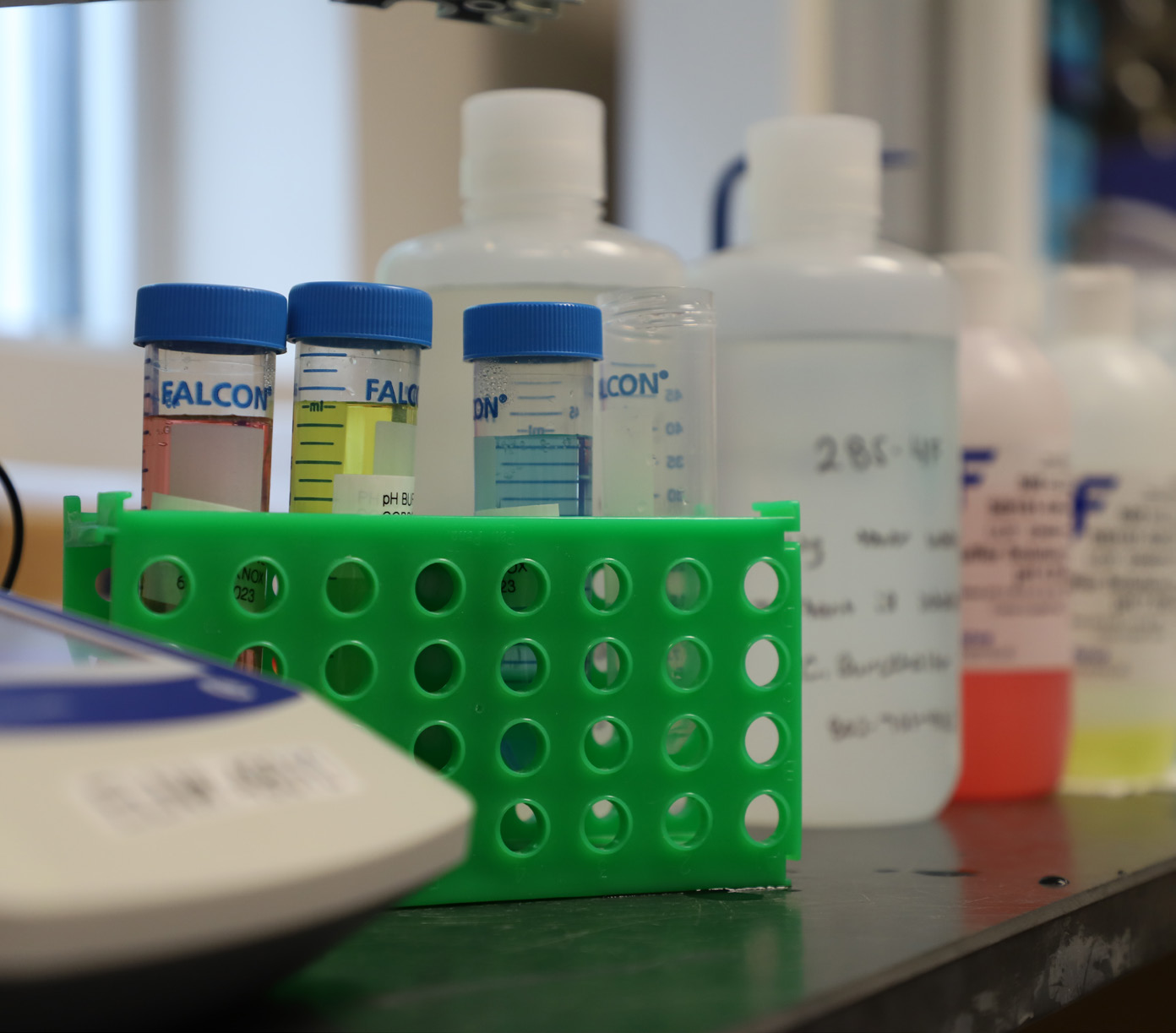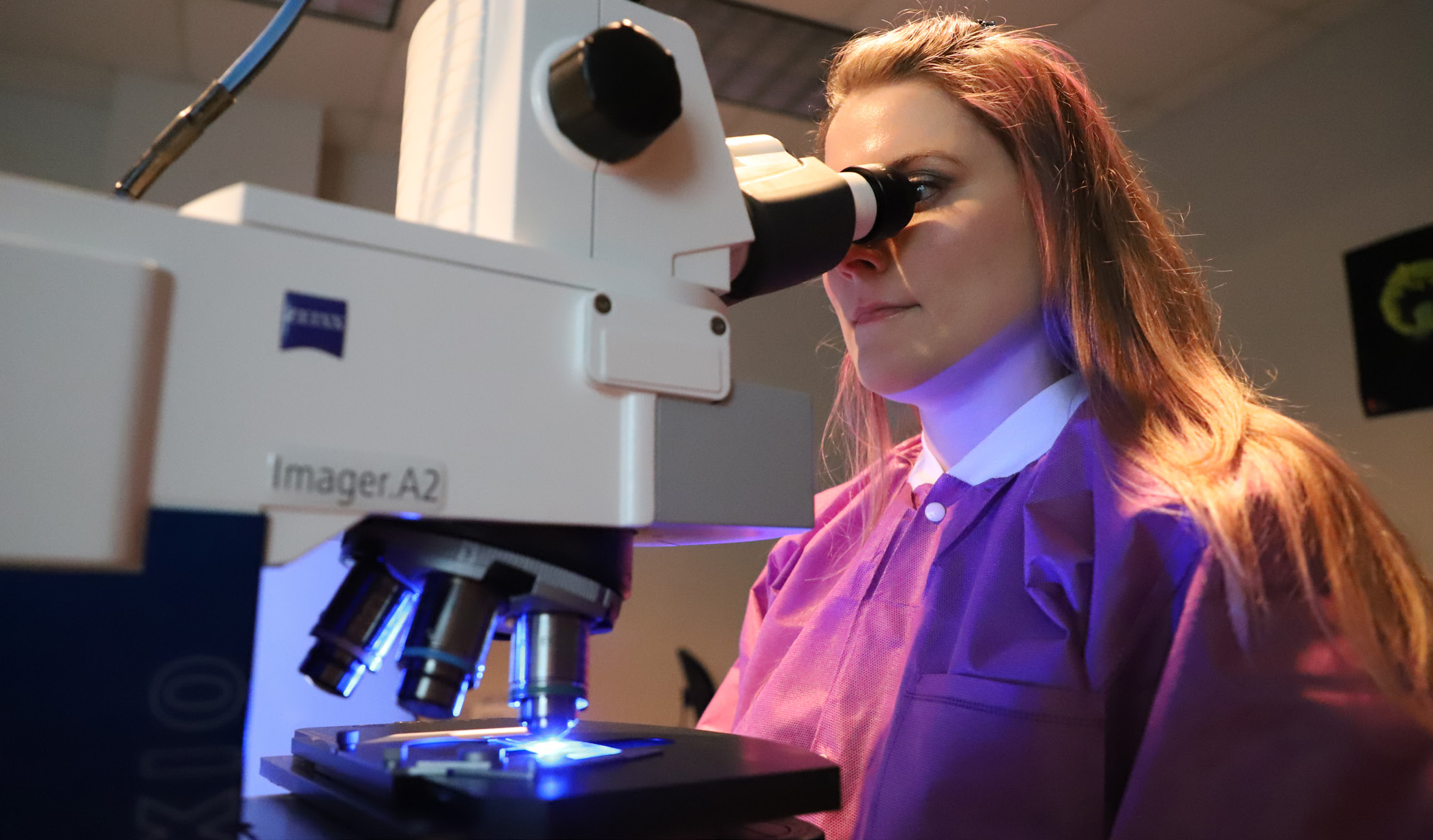SRNL Expands Biological Research, Biotechnology Programs
“We were trying to sequence microbial samples from the L-basin on the Savannah River Site to see how the microbes were tolerating the radiation there.” – Nate Losey

Courtney Burckhalter, a research associate in Savannah River National Laboratory’s biological and analytical sciences group, prepares samples taken from one of the 24 Savannah River Site cooling towers. Burckhalter’s group, which is part of SRNL’s division of earth biological and quantitative system science, helps keep Savannah River Site workers safe from Legionnaires’ disease. SRNL photo by Chris O’Neil, APR.
Savannah River National Laboratory is well known for its body of work in tritium, development of technologies for the disposition of nuclear wastes, and advancements in environmental remediation. Not as widely known is SRNL’s work in biological research. For nearly 25 years, SRNL also conducted applied research related to microbiological processes focused on bioenergy and environmental processes. Today, Savannah River National Laboratory is expanding its work in biological research and biotechnology.
Biomanufacturing at SRNL is poised to take on renewed interest as the Advanced Manufacturing Collaborative opens in 2025. SRNL’s Director, Vahid Majidi, sees biomanufacturing as a means to, “apply non-fossil fuel-based hydrocarbons that still allow the use of modern processes familiar to industry to produce materials we all use every day.”
Corey Radtke, biomanufacturing lead in SRNL’s Earth Biological and Quantitative System Science Division, said SRNL is expanding its biological competence and expertise so that the Lab can help assist commercial successes stemming from fundamental microbiological and molecular processing that drives environmental, advanced biomanufacturing, and national security processes. “SRNL leverages a strong history regarding analysis and understanding of complex microbial and chemical processes in aquatic and subsurface environments to allow interrogation of coordinated biological processes at process levels, considering nucleic acid, protein and metabolite levels, letting the bottom line drive decisions, not necessarily the metrics along the way.” Radtke said.
For Radtke, SRNL’s tag line of we put science to work means accepting tradeoffs and pivoting to economical solutions, embracing costs and energy requirements of feedstocks, capital equipment sensitivities, material throughput capacity, including costs such as labor and product purification, against the market values and volumes of the produced materials. To him it means embracing the reality of biomanufacturing’s technoeconomic analysis, looking at it, and asking, what will work and what can we do to make this work. “What pathways emerge when we take this sober-minded reality, including the full lifecycle analysis, the full carbon footprint, what are the types of things that jump out at us,” said Radtke. “There are relationships and synergies that jump out at you that are very much doable, but for some reason people aren’t doing it quite yet, and that is tremendously exciting. There are commercial interfaces to go after that make a lot of sense,” he said.
Brady Lee, director of SRNL’s Earth Biological and Quantitative System Science Division, said he envisions the division working in the development of sensors and biosensors for environmental, bioenergy and nonproliferation monitoring. Lee said coupling those sensors with machine learning and artificial intelligence, as is being done in the ALTEMIS project, could provide real time and actionable information. “We’re starting to bring in new areas of research both from environmental management, bioenergy and defense related organizations,” said Lee.
Another area of biological research at SRNL involves understanding what genetic markers make microbes resistant to radiation.

The tools of the Legionella program researchers await their use in the biological and analytical sciences laboratory at Savannah River National Laboratory. The chemistry of water samples taken from 24 Savannah River Site cooling towers is part of understanding if conditions are favorable or unfavorable – for the development of Legionella pneumophila. SRNL photo by Chris O’Neil, APR.
“We were trying to sequence microbial samples from the L-basin on the Savannah River Site to see how the microbes were tolerating the radiation there,” said Nate Losey, a postdoctoral research associate in the biological and analytical sciences group, under Lee’s Earth Biological and Quantitative System Science Division. “We were collaborating with New Mexico Tech and they were studying some organisms that were very radiation resistant and we thought if we could figure out what made those organisms radiation resistant, could that property be transferred to other organisms?”
“If we know what these radiation resistant biomarkers are, and if we could come up with the ability to transfer those to non-radio-resistant microbes, we could possibly find additional remediation processes,” said Lee. “If you had a microbe that broke down the organic portion, and then were able to give it the ability to survive in those high radioactive environments, they you’re basically taking out one component of the mixed waste. That decreases cost.”
Biofilms and their relationship with corrosion is another area of research for Losey. Instead of looking at radio resistant microbes for remediation, Losey and other researchers are looking at microbes’ effect on metals, including those metals used in radiological storage and processing.
“Biofilms are layers that microbes produce on surfaces when they grow and they secrete a lot of gooey organics,” said Losey. “It helps them stick, it’s part of their life strategy, and sometimes the microbes seem to enhance the rate at which corrosion occurs. Metal will develop pitting and start to corrode at an accelerated rate where biofilms are present,” he said. Courtney Burckhalter, a research associate in SRNL’s Biological and Analytical Sciences Group, works in the L-Basin Corrosion Monitoring Program, where biofilms and corrosion are studied. Burckhalter samples the water surrounding spent fuel rods stored in the basin to see what bacteria in the water is contributing to corrosion and the results of the analysis are provided to L-Basin.
Losey is also working to DNA sequence microbes in a metal contaminant wetland. Tims Branch, on the Savannah River Site, has a lot of uranium – mostly depleted uranium – in it. “That’s not so much a radiological concern but uranium also isn’t necessarily healthy so we want to see how the uranium is being trapped in the wetland and how microbes are contributing to that process,” he said.
A challenge in studying the wetland is attempting to determine if the uranium is sticking to organic material or if it’s sticking to iron, but in either case, Losey says, the microbes are likely involved in that process.
Losey said he’ll soon start work on his recently funded Laboratory Directed Research and Development project that proposes to use microbes to enhance methane production in a landfill environment, using an electrolysis cell to assist the microbes. “I like the idea of using microbes and electrolysis cells, it’s sort of a way of combining two different types of technologies,” he said. “The Three Rivers Landfill [on the Savannah River Site] collects waste from the surrounding counties, and like many landfills, once you load trash into it, the landfill starts to produce methane as the result of anaerobic decomposition. Microbes help break down that trash some more, producing more methane. Three Rivers installed a collection system for that and sells it as a primary constituent of natural gas,” said Losey.

Courtney Burckhalter is using an epifluorescence microscope to search for signs of Legionella neumophila. Samples are regularly taken and analyzed for signs of Legionella pneumophila or the conditions conducive to the bacteria’s growth. SRNL photo by Chris O’Neil, APR.
For all of the focus on new applications, there is a part of SRNL’s biological research that has been protecting the health of Savannah River Site employees for decades.
There are 24 cooling towers across the Savannah River Site used to reject heat from buildings and processes on the 310 square mile site. Water is circulated through the towers, passing through a condenser where the water becomes heated, and that heat exchange is an ideal environment for Legionella pneumophila – the bacteria that cases the potentially deadly Legionnaires’ disease. SRNL’s Legionella program ensures water used at the towers is regularly sampled and examined for the presence of Legionella pneumophila or the conditions – conductivity, pH, bromine and chlorine concentrations – that promote or inhibit the bacteria’s growth. Burckhalter, along with Anna Sophia Knox, Ph.D., analyze the water chemistry of the samples, filter the samples and prep the filtered material for microscopic examination using an epifluorescence microscope.
As a member of the Battelle family of laboratories, SRNL follows the eight safe conduct of research principles, which includes the principle that a healthy respect is maintained for what can go wrong. Despite the handling of samples containing Legionella pneumophila, and other microorganisms, no one has fallen ill or been infected. Lee aims to maintain that record, even as the Lab broadens its work in biological research and biotechnology. One step toward that goal was the Lab’s attainment of Biosafety Level 2 (BSL2).
“We thought there are enough BSL3 facilities around the country and we could even go to one of our Battelle Savannah River Alliance partners to do that level of work,” said Lee. “But if SRNL were to attain the BSL2 capability, we’d be able to work with some of the various organisms that could be important to our work. When we do environmental sample work, we often do isolation enrichment, and once we run a molecular analysis, we find out that some or our isolates are pathogens. Having the capability to work with them and properly handle and dispose of them is helping build our capability in cell biology,” Lee said. SRNL attained BSL2 in September 2022, which allows the Lab to handle biological material including bacteria, human and animal cells, viruses, and organisms associated with human diseases. The microorganisms SRNL researchers will work with are those that either pose no risk of infection to humans or those that could potentially pose a risk of infection to humans, but are readily treatable (e.g. e-coli, legionella, etc.) In BSL2 workers wear lab coats and gloves and any work that could cause infection from aerosols or splashes is done within a biological safety cabinet, and an autoclave is used for decontamination for proper disposal of materials.
The National Academies of Sciences, Engineering, and Medicine’ publication “Successes and Challenges in Biomanufacturing” (proceedings of a workshop, 2023) quotes Paula Hammond (MIT and President’s Council of Advisors on Science and Technology [PCAST]) as saying estimates for the future value of the global bioeconomy range from $4 to $30 trillion by the end of the decade. She also said that currently, the United States lacks the biomanufacturing infrastructure and workforce required to scale biology-based prototypes to products and remain globally competitive. Savannah River National Laboratory’s Biological Research and Biotechnology plans to put science to work to help the United States be a leader in the field and to deliver the benefits of biotechnology to the nation.